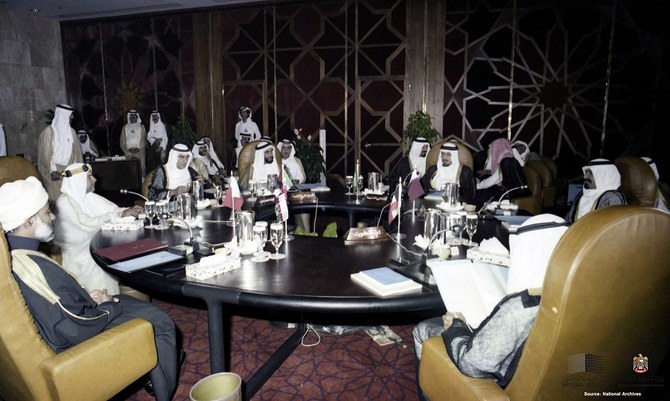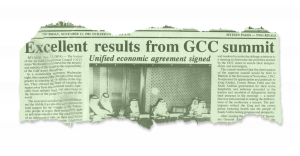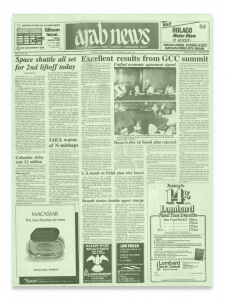- ARAB NEWS
- 06 Jul 2025

Abdel Aziz Aluwaisheg
The union of six Gulf states has accomplished a lot of what it set out to do
Summary
On May 25, 1981, the Cooperation Council for the Arab States of the Gulf was created at a conference in Abu Dhabi, bringing together the UAE, Saudi Arabia, Bahrain, Oman, Qatar and Kuwait in the conviction that “coordination, cooperation and integration between them serve the sublime objectives of the Arab Nation.”
The six-member Gulf Cooperation Council (GCC), as it came to be known, was formed primarily as an economic bloc, but its creation also reflected growing concern for the stability and security of the region in the wake of the Iranian Revolution.
Over the four decades since it was founded, the members of the GCC have not always seen eye to eye — in 2014, for example, a rift opened between the GCC and Qatar, which other members accused of failing to uphold mutual security agreements.
But the raft of economic, legal, security and political agreements, securing collaboration across fields ranging from energy, agriculture and telecommunications to customs, education and judicial cooperation, stand as testament to the value of an organization that, in the words of its original charter, continues ‘to effect coordination and integration between member states in all fields, leading to their unity.’
RIYADH: When, in January 1968, Britain announced its intention to leave the Gulf by 1971, it sent shock waves throughout the region. The search intensified for a new and more reliable security architecture. It took several steps, ending with the formation of the Gulf Cooperation Council (GCC) on May 25, 1981.
The charter of the Cooperation Council for the Arab States of the Gulf is signed by the heads of state of the UAE, Saudi Arabia, Bahrain, Oman, Qatar and Kuwait at a conference in Abu Dhabi.
GCC leaders sign a unified economic agreement at their second summit in Riyadh
Peninsula Shield, a joint GCC defense force, is established at headquarters at Hafr Al-Baatin in the northeast of Saudi Arabia.

A GCC customs union is created.
Introduction of the GCC common market.
Saudi Arabia, the UAE and Bahrain withdraw ambassadors from Doha, accusing Qatar of failing to abide by the agreement not to support “anyone threatening the security and stabil¬ity of the GCC whether as groups or individuals.”
The GCC announces the formation of a regional police force, based in Abu Dhabi, at its annual meeting.

Bahrain, Saudi Arabia, the UAE and Egypt cut diplomatic ties with Qatar, accusing Doha of collaborating with Iranian-backed terrorist groups.

Following an extraordinary meeting of all six health ministers in Riyadh, the GCC issues a coronavirus statement introducing preventive measures at all borders.
The first step was the formation of the UAE. During the three years between the British announcement of its impending withdrawal and the actual termination of its protectorate and military presence in the Gulf on Dec. 16, 1971, six emirates succeeded in forming the United Arab Emirates, which was founded on Dec. 2, 1971. Ras Al Khaimah, the seventh emirate, joined a few months later. Bahrain and Qatar contemplated joining the union for a while, but in the end bowed out, despite efforts by Saudi Arabia, Kuwait and Britain to persuade them.

“Optimism expressed recently about the goals and achievements expected to accrue from the deliberations of the Gulf Cooperation Council (GCC) during its summit in Riyadh has proven to be well-founded.”
From an Arab News editorial on Nov. 12, 1981 after the second GCC summit in Riyadh
The search continued for a larger framework to include the rest of the Gulf states. Sheikh Jaber Al-Sabah of Kuwait championed the renewed efforts. In May 1976, he formally called for the establishment of the GCC during a visit to the UAE, whose President Sheikh Zayed strongly supported the idea. In November 1976, in Muscat, a security framework that would have also included Iraq and Iran was discussed but abandoned because of fundamental differences over the concept, especially between Iran and Iraq.
Efforts continued to establish the GCC without those two countries. Saddam Hussein of Iraq tried to hinder those efforts and the Soviet Union was also opposed, but progress continued, especially after the revolution in Iran in February 1979 produced a clerical regime explicitly seeking to export its brand of revolution and undermine the security of its neighbors. The new regime in Tehran formed armed groups in Bahrain and Saudi Arabia to carry out its agenda, making it imperative to close ranks to meet the new threat.
Some favored focusing on security and military integration, while others wanted the new organization to emphasize soft power and economic integration
Abdel Aziz Aluwaisheg
In October 1979, in a meeting held in Taif, Saudi Arabia, the general framework of the GCC was agreed, but differences remained on some issues. Some favored focusing on security and military integration — even a formal military alliance — while others wanted the new organization to emphasize soft power and economic integration. In 1980, Saudi Arabian Foreign Minister Prince Saud Al-Faisal was given the task of bringing the different views together and leading the exercise of drafting the charter, supported by Kuwaiti Foreign Minister Sheikh Sabah (the current emir of Kuwait), Bahraini Foreign Minister Sheikh Mohammed bin Mubarak, and others. A flurry of meetings of ministers and experts took place in the early months of 1981, in Kuwait, Riyadh and Muscat, to finalize the draft, which was adopted by the heads of state on May 25, 1981, in Abu Dhabi, in the first formal meeting of the new organization.

The GCC Charter was a compromise between the different formulations discussed for the new group. It did not privilege a particular emphasis, but called for “coordination and integration between member states in all fields, leading to their unity.” The reference to unity as a goal was important to guide the work of the organization. The reference to “all fields” gave the impetus for the formation of institutional structures dedicated to different branches of integration, including political, economic and security.
Today, the GCC Secretariat employs more than 1,000 staff from the six member states and hosts the main policymaking divisions of the organization. Its work is aided by about 30 specialized entities that deal with specific issues. There are economic organizations such as standards, patents, intellectual property and investment, as well as military and security organizations.
Since its inception in May 1981, the GCC has undoubtedly accomplished a lot of what it set out to do four decades ago. Economic tools, such as the free trade area, which was set up in 1983, the customs union (2003) and the common market (2008), have created great synergies between member states that have led to improved efficiencies and wide and dynamic markets. In 1981, the combined gross domestic product (GDP) of the six member states was just shy of $200 billion, and most GCC states were performing poorly in economic and social indicators. At that time, most GCC states had just shaken off British rule, which had lasted more than 200 years for some, impoverished their economies, and ossified their political and social development. As a result, they were underperforming economically and needed the solidarity and support of other GCC members. Today, the combined GCC GDP is about $1.6 trillion — an eight-fold increase over 1981. Other significant achievements were also made, including the establishment of the unified military command in November 2018 and the GCC police force in 2014.
However, a lot remains to be done to reach the goal of “unity” cited in the charter. The 40th summit, held in Riyadh last December, identified several areas that need to be re-energized to enable the organization to reach that goal. One area that was referred to in the 40th summit was the reform of the GCC’s institutions, including the GCC Secretariat and the 30-odd other entities in its orbit. Governance in particular needs to be overhauled to provide more transparency, accountability and efficiency. The emerging and almost existential challenges that the region faces require new ways of doing things. Business as usual is no longer adequate. King Salman’s vision for the GCC, which was adopted by all leaders in December 2015, started that process, but the pace of change has not been fast enough.